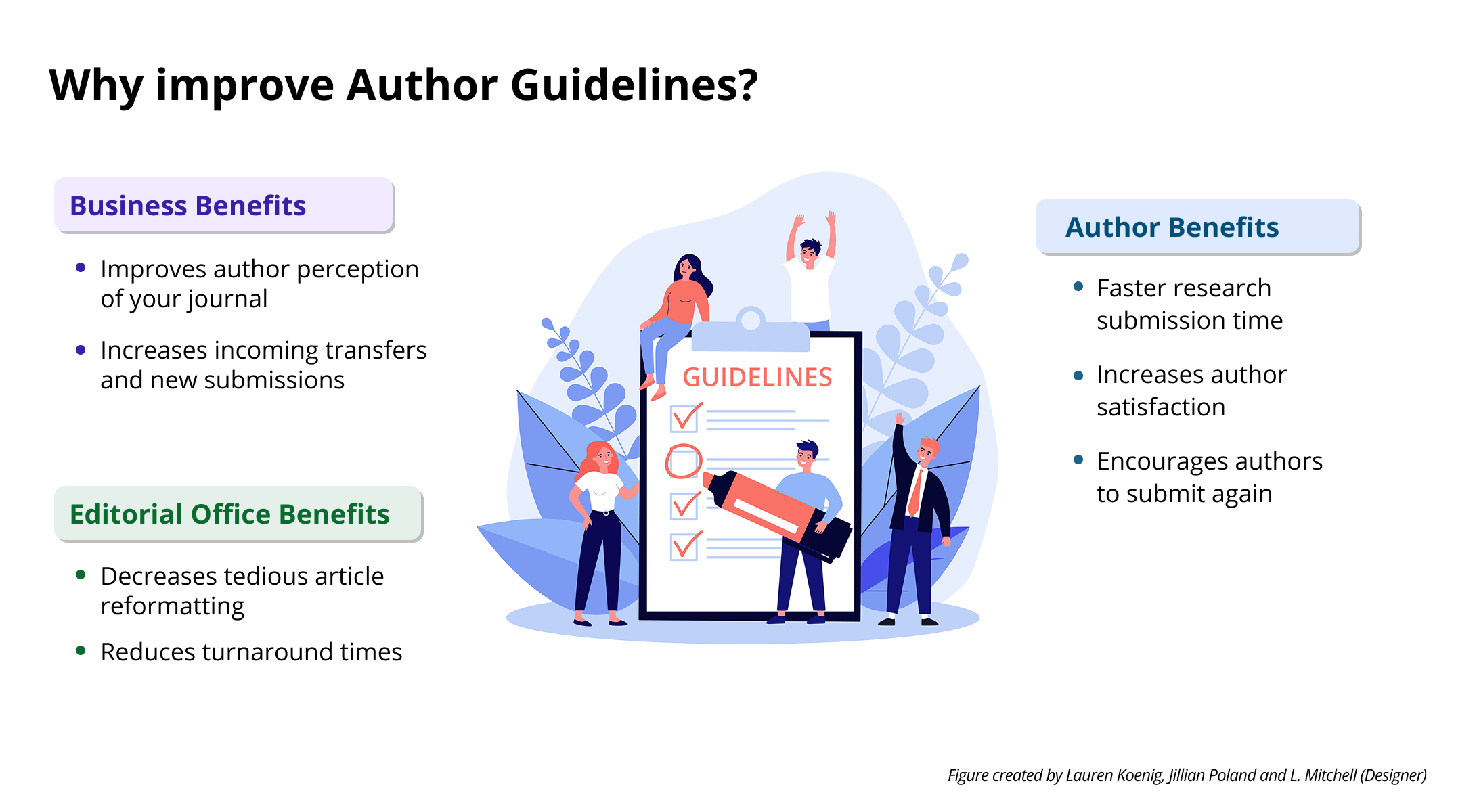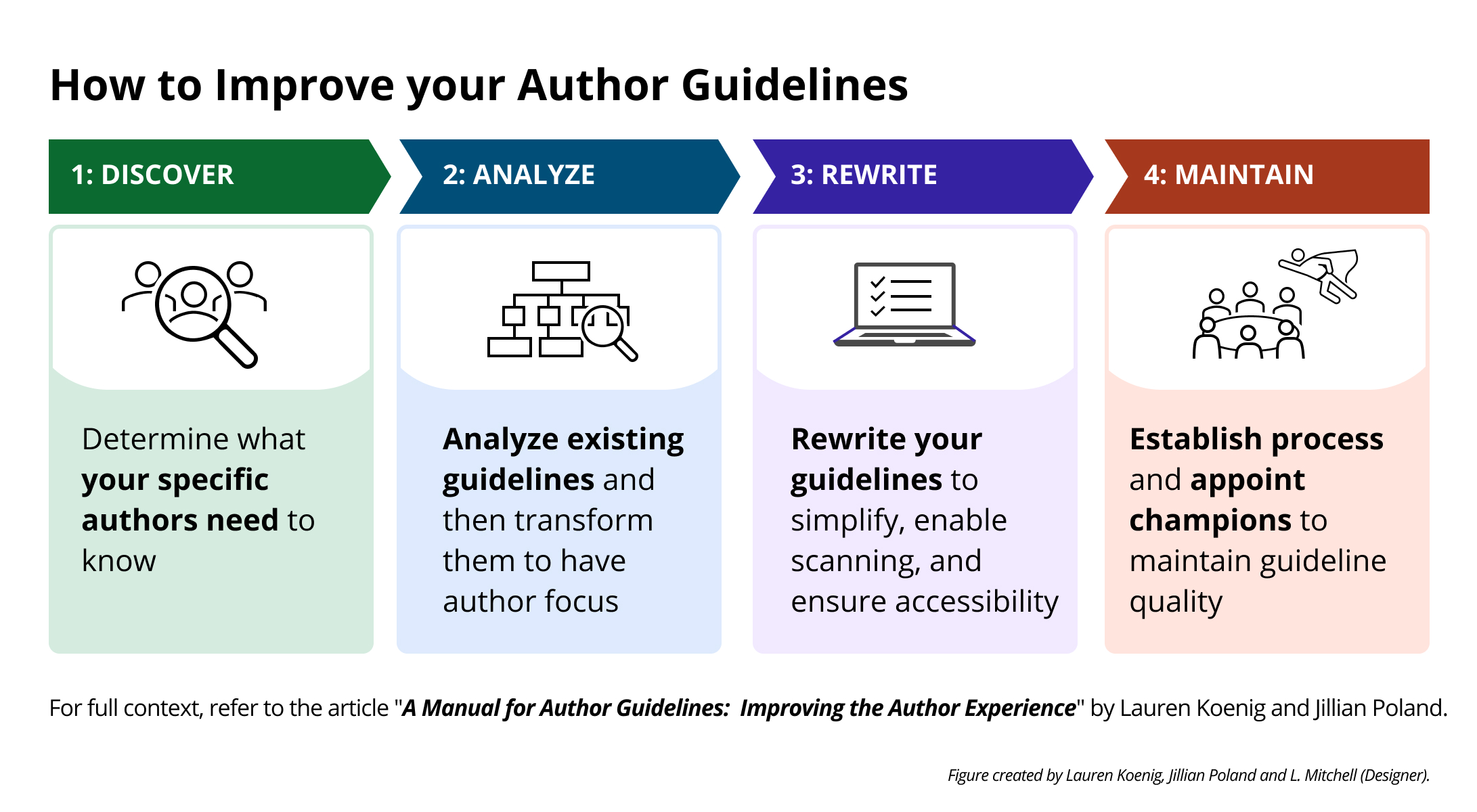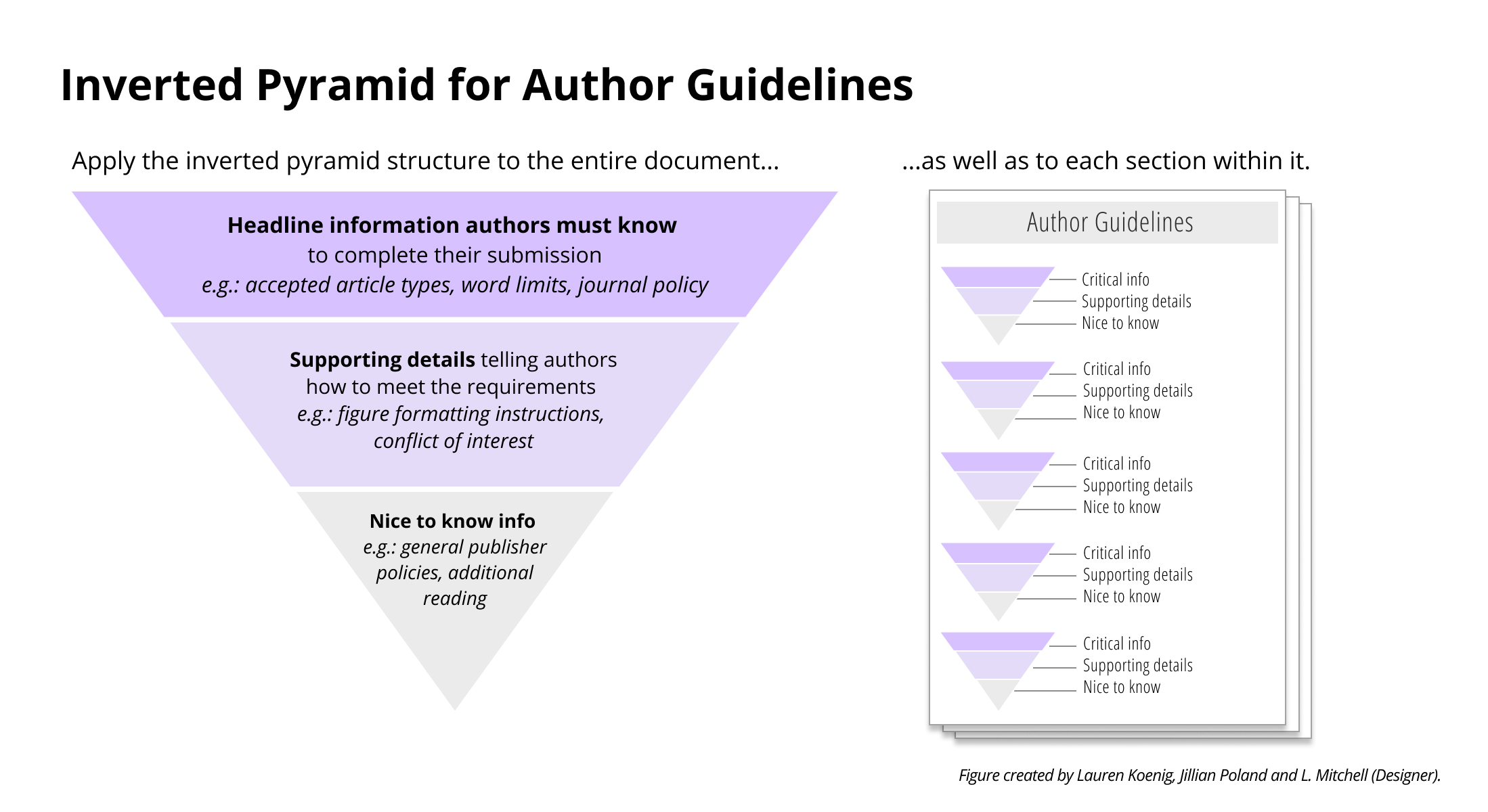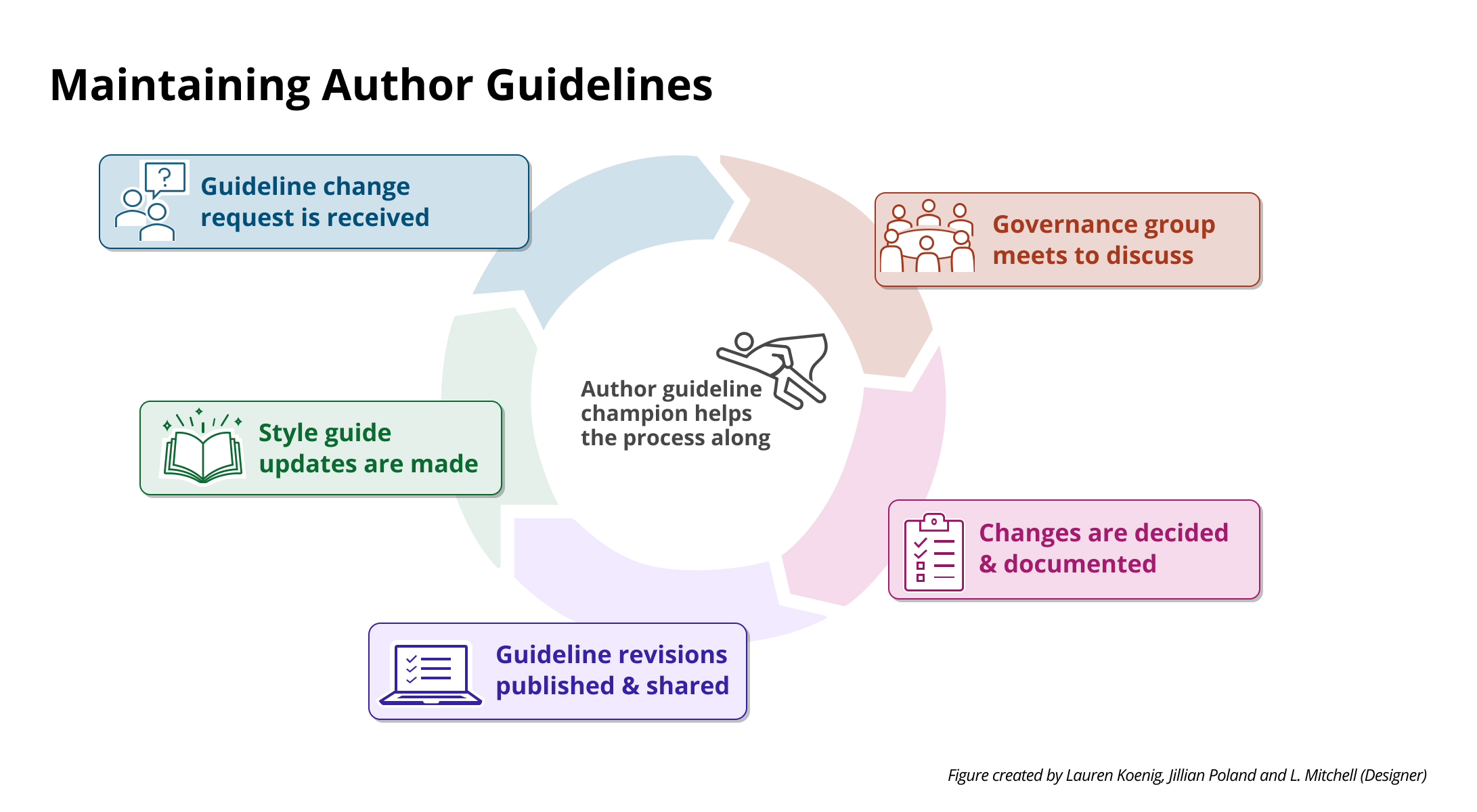Journal author guidelines are often the first line of communication between editors and authors, and they play a large role in determining the quality and volume of submissions received by an academic journal. Thoughtfully analyzing and designing author guidelines is crucial for research journals because it benefits both authors and editorial offices (Figure 1).

As user experience (UX) researchers at Wiley, we have cumulatively analyzed feedback from thousands of authors across research disciplines about the role of author guidelines in publishing. A consistent theme that emerged was that clear, well-structured author guidelines influence how favorably authors perceive a journal and where they will ultimately submit their manuscripts. Authors tell us that among journals with similar metrics, they tend to select a journal based on the clarity of their guidelines.
We also found that when authors are provided effective guidelines, it is easier for them to properly prepare their submissions the first time. For societies and publishers that encourage manuscript transfers between journals, standardized guidelines simplify the transfer process, making it easier for authors to compare requirements and choose whether to accept a transfer.
Subsequently, the editorial office receives fewer requests for help, spends less time sorting through improperly prepared files, and returns fewer manuscripts for corrections. This decreases the overall time from submission to publication of the final article.
We have developed strategies to enhance both the content and design of author guidelines to help editors reap these benefits. In this article, we will walk you through key steps to improve your guidelines, as well as how to maintain them and manage changes to ensure they remain effective for years to come (Figure 2).

The (Re)Writing Process
Authors across disciplines and with varying degrees of publishing experience will come to your journal with different needs. These authors must sort through a variety of requirements when preparing their submissions, depending on the kind of research data they generate and the type of article they want to publish. How do you write one document tailored to so many user perspectives and article types?
Focus on the Author
Writing clear guidelines requires you to deeply consider your intended audience and their preexisting knowledge of publishing.
To start understanding your authors, conduct a thought exercise drawing on your knowledge of the journal and the expertise of the editorial board. Consider questions that reveal how authors interact with your guidelines. Examples include:
- Are our authors predominantly early-career, advanced, or a mix of both?
- What are common questions authors ask the editorial office?
- How does our specific discipline influence the way authors approach submission?
If possible, collect and analyze author feedback through a short survey designed to understand who reads your author guidelines, their needs, and behaviors. Examples of survey questions:
- How many papers have you submitted to a journal for publication in the last 5 years?
- What was your primary reason for reading the author guidelines?
- Did the author guidelines provide the information you were looking for?
We recommend learning more about survey design best practices by reviewing the article by Costantini, “Authoring Surveys: Guidance for Societies, Publishers, and Publishing Professionals”.1
You can generate valuable insights by including an open-ended question that asks for suggestions for improving the publishing experience. Analyzing these responses can reveal authors’ priorities and challenges. To conduct thematic analysis, group similar comments, such as questions about “revision” or those about “editorial emails,” on a virtual whiteboard. Creating a visual representation of these concerns can guide you in how and where to address potential issues in your author guidelines.
Assess Your Current Author Guidelines Structure
Now that you have developed an understanding of your authors as the foundation for your new guidelines, you will want to break down your current author guidelines into its distinct sections.
Assess each section in your guidelines and label them with one or more broad categories, such as “submission requirement,” “journal policy,” or “figure format instructions.” Structuring, organizing, and labeling the content of your current guidelines will help you make sense of large amounts of text. Use this activity to document where you might need to write new material or remove redundant content. The categories will also be useful in defining a new structure.
Develop an Author-Focused Outline
Once you have identified the different parts of your author guidelines, rearrange each section to make the most sense from an author’s perspective. This is where it is important to think back to your research about authors’ values. For example:
- Clearly describe revision requirements, like using tracked changes to mark edits, to prevent authors from needing to recreate their revisions retroactively
- Highlight open access fees and discounts upfront to help authors who must choose a journal based on available funding
- Detail any required information authors need to collect from external sources, like their funder or institution, so that they can factor these steps into their submission timeline
There are some general best practices you can follow that apply regardless of your specific author types:
- Group similar content together. Use the section categories you developed when assessing your current structure to group similar content together. For example, group all data-related instructions (i.e., data sharing policy, data availability statement requirement, and data formatting instructions) in one section.
- Use the Inverted Pyramid writing style. Present information in order of importance, starting with the most critical details (Figure 3). This helps authors determine if their manuscript meets the basic criteria. Then, follow with manuscript preparation or post-acceptance details.2 You should also apply this pattern within sections by prominently stating the most important part of each policy, followed by specifics such as any background information or step-by-step instructions.
- Help authors focus only on the information they need. Consider authors’ varying experience levels and submission needs in organizing your guidelines. One approach is to apply the tenets of information foraging theory, which suggests that people seek information in a way similar to how animals forage for food—they want to find valuable information with minimal effort.3

Within our context, this can entail signposting high-level requirements with headers or tables for experienced authors, so they can move through the instructions faster, and providing detailed descriptions further down for those who need them. For example, experienced authors might only need to know that a journal requires them to provide an ORCID because they already understand and have a persistent digital identifier. They can skip any text with supporting details. In comparison, a novice author may want to read an explanation about what an ORCID is and how they can create their own.
By structuring your guidelines this way, you present the information in a user-friendly, “choose your own adventure” style.
Rewrite and Simplify
In addition to reorganizing your existing content, you will likely need to rewrite current sections and create new sections. A common author complaint is that it is difficult to find specific journal requirements within long, complicated paragraphs. Simplify your writing to make it easier for authors to quickly locate and understand the necessary information
Here are 3 recommendations for making your author guidelines easy to follow:
- Incorporate industry standards. Many journals use different terms for the same topics, which can confuse authors. Avoid this by adhering to industry standards. This not only saves you time on creating new descriptions, but also helps authors recognize familiar terms. For example, use the NISO Standard Terminology for Peer Review instead of writing out multiple paragraphs to describe your journal’s review process.4
- Keep it simple. Using simple language makes instructions more accessible and minimizes the risk of misunderstandings. This approach benefits all readers, including multilingual authors who often rely on translation tools.7,8 Translation tools are more accurate with simpler language, making it easier for researchers globally to engage with content.7
Clear language also reduces cognitive load, which is crucial for authors who are neurodivergent, experiencing a cognitive disability, or who may struggle with complex instructions. With growing awareness of neurodiversity, simplifying language can help remove barriers for a large group of researchers.10-12
Authors are already navigating a sea of jargon in their fields and although some industry-specific terms cannot be simplified, that makes it even more important to simplify other content where possible. Aim for an 8th-grade reading level (around 14 years old) because it is similar to journalistic writing and ensures readability. Simplifying instructions will make the submission process smoother and less time-consuming for everyone, regardless of their academic experience. - Keep it brief. Most readers skim long text. Even though your audience may have advanced degrees, they are often busy. Work with this behavior by using short sentences, strategic paragraph breaks, and bullet points to highlight key information.
Consider Web Accessibility and Navigation
Once you have structured your guidelines to be author-centric and simplified your content, consider how authors will access these guidelines on your website.
Ensure Web Accessibility
You should ensure web-based author guidelines follow the latest web accessibility guidelines to accommodate all authors, including those using screen readers. In many parts of the world (including the United States and the European Union), accessible web content is no longer a recommendation—it is the law.5,6 Make your content accessible by using alt-text for images, descriptive linked text, and contrasting colors with readable fonts. We recommend adhering to the Web Content Accessibility Guidelines, an international standard set by the Web Accessibility Initiative.13
Enhance Navigation
Help authors navigate your page by using clear, descriptive headings that outline the logical flow of information and consider adding a table of contents or sidebar menu for quick and easy access to different sections.
Incorporate search engine optimization best practices when crafting headings to enhance searchability, ensuring key topics are easily discovered by search engines. If you are considering creating collapsible sections to help reduce information overload, keep hidden information to a minimum. It is important to use effective headings to signpost this content and ensure your site remains user friendly because hidden information will not appear in a search engine’s results or when authors use the find command (Ctrl+F).
Maintaining the Guidelines
Writing author guidelines is not a one-and-done task (Figure 4). Your journal policies will change as the industry and your team evolve. For example, a few years ago, only specialized journals needed an artificial intelligence (AI) policy. Now, journals across disciplines must include AI usage policies and weave them into existing guidelines. Your guidelines must be flexible enough to adapt to such changes without losing their clarity or tone of voice.

Here are some recommendations for maintenance:
- Make a style guide. As you draft your author guidelines, document your approach and rationale. When you or other editors make updates in the future, this documentation can serve as a useful reference to simplify updates and ensure consistency.
Include detailed rules on language and terminology to maintain a uniform tone and style. For example, decide whether your journal will address authors directly as “you” or in the third person as “authors,” and specify preferred terms for common concepts.
Think of it as writing notes in a cookbook to describe how and why you adjusted a recipe—the next time you make the dish, you get consistent results without repeating the decision-making process.
- Form a governance group. A single person cannot keep guidelines updated on their own. A governance group of subject matter experts can consult on the direction of the guidelines and determine if changes are needed. This group helps keep guidelines aligned with a common purpose.
Group members should represent key stakeholders, such as the managing editor, editor-in-chief, and associate editors. Larger organizations might also include a project manager and representatives from the legal and research integrity departments.
- Designate a “champion” for the author guidelines. When it comes to implementing the group’s recommendations, appointing a champion for the author guidelines can provide accountability.
A champion acts as the primary point of contact and decision-maker. Their duties might include managing updates, coordinating with different departments to check accuracy of the content, and ensuring compliance with regulations and standards like the Committee on Publication Ethics (COPE) or the Directory of Open Access Journals (DOAJ).14,15
- Establish a process for managing changes and keeping guidelines current. Change is inevitable. Prepare for changes by establishing a process for managing them. Determine how change requests are submitted, reviewed, and approved (typically involving your champion and governance group).
We strongly recommend keeping a log of changes made to the guidelines, including:
- A description of the change
- The reason for the change
- Who requested the change
- The date the change was made
Schedule regular reviews of the entire guidelines to ensure they remain cohesive and up to date. At each review, go over the log of changes to assess the overall impact and identify any new policies needed or outdated instructions to be removed or updated. Always keep in mind any discipline-specific updates in your journal’s field.
Conclusion
Crafting effective author guidelines requires a thoughtful approach that combines user-centric design, clear language, and adherence to industry and accessibility standards. Although having all this structure around guidelines can feel overly meticulous, these documents are the face of your journal. Outlining a clear strategy for maintaining these instructions will ensure they remain useful and relevant over time.
By investing time in creating effective guidelines, you can improve the overall submission experience and establish a productive, long-lasting relationship between your journal and your authors.
Acknowledgements
We would like to thank Lara Roth-Mitchell for creating the figures used in this manuscript and our colleagues at Wiley for their valuable feedback during the writing process. We would also like to thank Anna Jester. Her invitation to us to share findings at the 2024 Council of Science Editors annual meeting inspired us to write this article.
References and Links
- Costantini RA. Authoring surveys: guidance for societies, publishers, and publishing professionals. Sci Ed. 2024;47:23–26. https://doi.org/10.36591/SE-4701-11.
- Nielsen J. Inverted pyramid: how to structure content for readability. Nielsen Norman Group; May 15, 2023. https://www.nngroup.com/articles/inverted-pyramid/.
- Budiu R. (2019, November 10). Information foraging: a theory of how people navigate on the web. [accessed April 7, 2025]. Nielsen Norman Group; November 10, 2019. https://www.nngroup.com/articles/information-foraging/.
- [NISO] National Information Standardization Organization. Peer review terminology standardization. [accessed April 7, 2025]. NISO; July 5, 2023. https://www.niso.org/standards-committees/peer-review-terminology.
- European Union. Accessibility of public sector websites and mobile apps. [accessed April 7, 2025]. EUR-Lex; October 26, 2016. https://eur-lex.europa.eu/legal-content/EN/TXT/HTML/?uri=LEGISSUM%3A4314916
- ADA.gov. Guidance on web accessibility and the ADA. U.S. Department of Justice Civil Rights Division; March 18, 2022. https://www.ada.gov/resources/web-guidance/#top.
- plainlanguage.gov. Why use plain language? [accessed April 7, 2025]. U.S. General Services Administration. https://www.plainlanguage.gov/about/benefits/.
- Amano T, Ramírez-Castañeda V, Berdejo-Espinola V, Borokini I, Chowdhury S, Golivets M, González-Trujillo JD, Montaño-Centellas F, Paudel K, White RL, et al. The manifold costs of being a non-native English speaker in science. PLOS Biol. 2023;21:e3002184. https://doi.org/10.1371/journal.pbio.3002184.
- Steigerwald E, Ramírez-Castañeda V, Brandt DYC, Báldi A, Shapiro JT, Bowker L, Tarvin RD. Overcoming language barriers in academia: machine translation tools and a vision for a multilingual future. BioScience. 2022;72:988–998. https://doi.org/10.1093/biosci/biac062.
- Doyle N. Neurodiversity at work: a biopsychosocial model and the impact on working adults. British Med Bull. 2020;135:108–125. https://doi.org/10.1093/bmb/ldaa021.
- ADHD Aware. What is neurodiversity? [accessed April 7, 2025]. ADHD Aware; 2022. https://adhdaware.org.uk/what-is-adhd/neurodiversity-and-other-conditions/.
- Taylor H, Zaghi A, Rankin S. Marginalising dyslexic researchers is bad for science. eLife. 2023;12:e93980. https://doi.org/10.7554/eLife.93980.
- W3C. W3C accessibility standards overview. [accessed April 7, 2025]. W3C Web Accessibility Initiative; 2019. https://www.w3.org/WAI/standards-guidelines/.
- https://publicationethics.org/
- https://doaj.org/
Lauren A Koenig, PhD (https://orcid.org/0000-0001-5740-3095), and Jillian Poland (https://orcid.org/0009-0007-5731-013X) are with John Wiley & Sons.
Opinions expressed are those of the authors and do not necessarily reflect the opinions or policies of their employers, the Council of Science Editors, or the Editorial Board of Science Editor.
